Sometimes in cooking you have to break the rules. This savory shrimp pasta—a clever mash-up between cheesy-peppery Cacio e Pepe and garlicky-lemony Shrimp Scampi–does just that with delicious results. This easy 40-minute recipe is just the thing you need to shake up your weeknight dinner rotation!
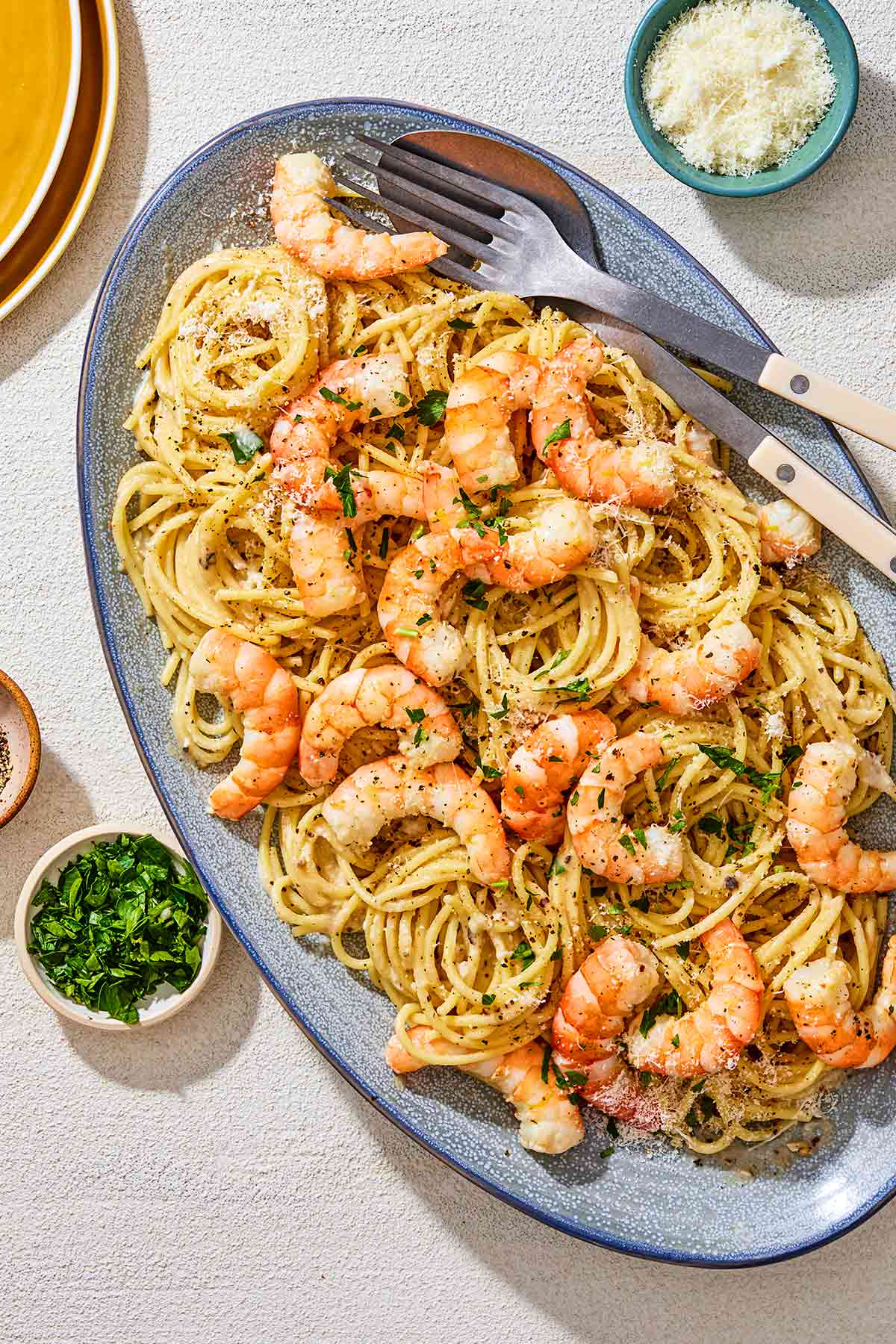
Italians are famous for their many cooking “rules.” Among them: Don’t mix seafood with cheese; and never mess with a classic. This shrimp pasta recipe breaks both those rules, but somehow it works. Trust me!
Cacio e Pepe is one of Rome’s most famous pasta dishes. Traditionally, it is made with just three ingredients: aged Pecorino Romano cheese, freshly ground black pepper, and pasta. Shrimp Scampi, a classic Italian-American recipe, combines shrimp with a spicy, garlicky lemon sauce.
Putting the two together may be unorthodox, but I promise this recipe delivers! And if you think about it, one of the most iconic Italian-American dishes–the Caesar salad–paved the way, combining parmesan cheese and anchovies to prove that cheese and fish can be a match made in heaven!
The shrimp’s pan juices mingle beautifully with the creamy cheese and pepper sauce, adding depth to this simple pasta dish. Serve with a 5-minute Lemon Parmesan Lettuce Salad, pour yourself a glass of dry white wine, and toast to breaking the rules!
Table of Contents
- Ingredients for Cacio e Pepe with Shrimp
- How to Make this Shrimp Pasta Recipe
- If You Bought Peel-On Shrimp: Peel and Devein
- Get Ready to Cook
- Cook the Pasta and Sauté the Shrimp
- Finish and Serve
- Ways to Mix it Up
- What to Serve with Shrimp Pasta
- You’ll Also Like: More Shrimp Recipes
- Cacio e Pepe with Garlicky Sautéed Shrimp Recipe
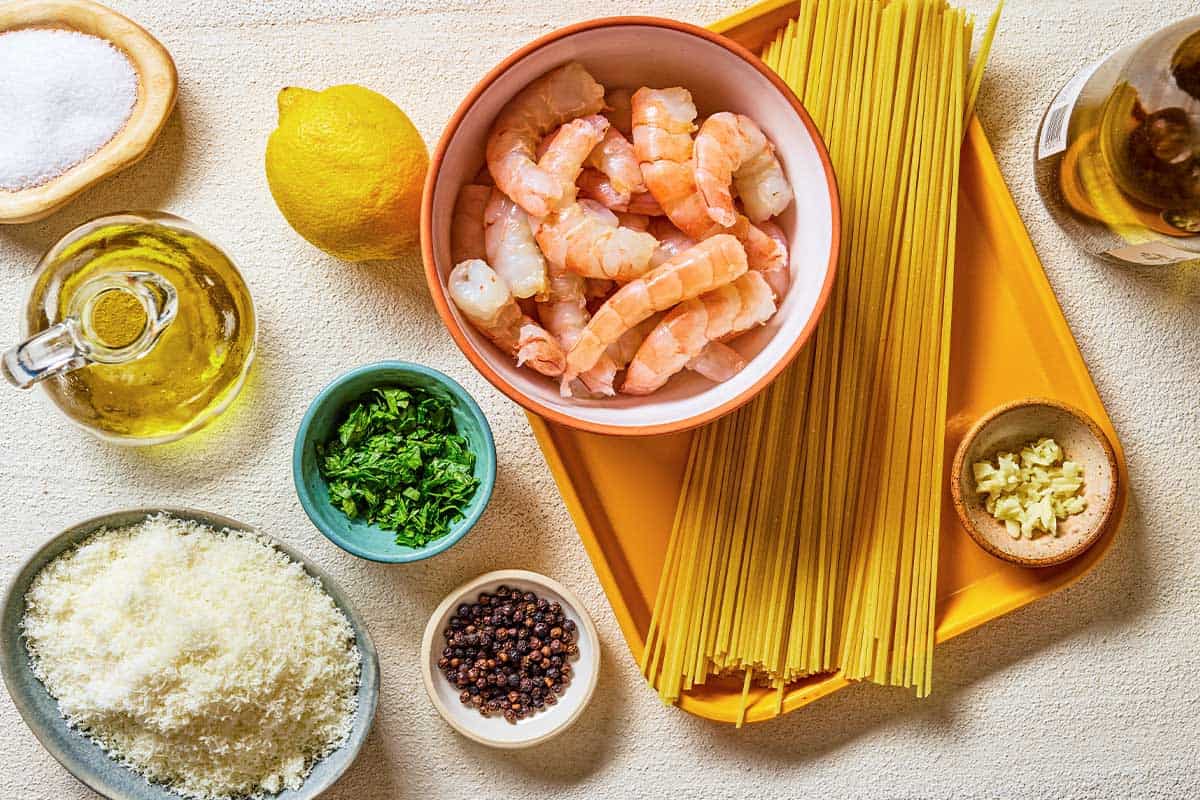
Ingredients for Cacio e Pepe with Shrimp
You don’t need any special ingredients to make shrimp pasta. But as with all Italian cuisine, the results depend on the quality of ingredients, so be sure to buy your shrimp from a reliable source and use good quality Pecorino Romano cheese. Two of my favorite brands are Fulvi or Locatelli.
- Shrimp: I prefer large shrimp for shrimp spaghetti rather than colossal or jumbo, which in my opinion are better for grilling and serving on their own rather than as part of a shrimp pasta dish. Look for fresh shrimp still in their shells rather than shrimp that have already been peeled and deveined. The shell preserves the shrimp’s moisture and freshness. For the best quality, choose wild or sustainably farmed shrimp. You can use frozen shrimp for this recipe, but, again, look for high-quality wild or sustainably farmed.
- Extra virgin olive oil: Choose a good Italian olive oil, like our Nocellara, to sauté the shrimp, giving the sauce a pleasantly fresh, rich flavor.
- Aromatics: Garlic, a splash of dry white wine, lemon juice, and lemon zest add bright flavor to the shrimp and cut the richness of the cacio e pepe sauce.
- Pecorino Romano cheese: This aged sheep’s milk cheese has a pale hue, black rind, and a dry, crumbly texture that makes it good for grating. I recommend using a microplane and grating it yourself so it’s light and fluffy.
- Seasoning: To get the most flavor, use whole black peppercorns and grind them yourself with a mortar and pestle or a spice grinder. This ensures your pepper will have lots of “bite.” Pre-ground pepper tends to be too dull for cacio e pepe since pepper is a major component of the flavor rather than just a simple seasoning. Kosher salt enhances the flavor.
- Pasta: I prefer spaghetti or spaghettini, which is slightly thinner than spaghetti.
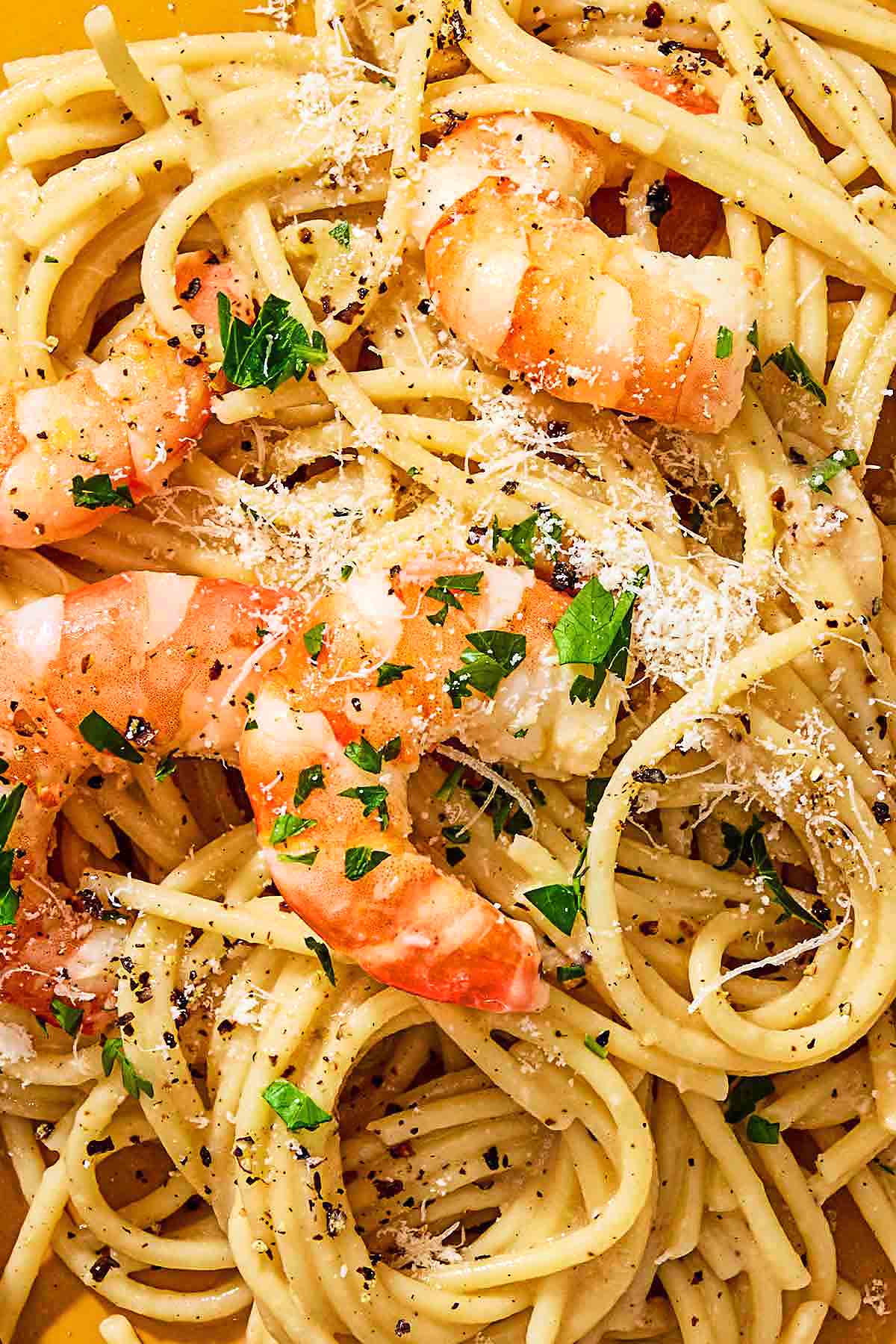
How to Make this Shrimp Pasta Recipe
Shrimp Cacio e Pepe is easy to make but it requires a little elbow grease. Make sure to stir the cheese sauce vigorously to achieve a nice creamy consistency.
If You Bought Peel-On Shrimp: Peel and Devein
- Prep the shrimp. If you’re using frozen shrimp, you’ll need to defrost first. Remove as many shrimp as you plan to cook (18-24) and put them in a zip-top bag. Place the bag in a bowl of cold water set in the sink. Place a weighted object, such as a plate, lid, or another bowl, on top of the bag of shrimp to weigh it down. Let sit for about 30 minutes, until thawed.
- Peel the shrimp. If the head is attached, just twist and pull it off. Then gently pull off the small legs from the bottom of the shrimp. Hold the shrimp by the tail and use your fingers to crack open and peel away the shell starting at the head end. As you reach the tail, use your other hand to keep the small tail section attached as you peel (or you can remove the tail too if you’d like.) If the shell is proving difficult to remove with just your fingers, you can use kitchen shears, a small paring knife, or use a shrimp peeler.
- Devein the shrimp. If there is a black vein running along the back of the shrimp that the peeler has not removed, use your fingers or the tip of a pairing knife to pull it out, and discard it. Transfer the shrimp to a clean plate or bowl as you clean them and discard the shells.
- READ MORE: Guide to Cooking and Buying Shrimp
Get Ready to Cook
- Put a pot of water on to boil. Fill the pot with just enough water to submerge the pasta. Use a little less water than you normally would so the water will be extra starchy as the pasta cooks. This will help in making a creamy sauce.
- Toast and grind the peppercorns. Place 1 tablespoon whole peppercorns in a large skillet and set it on medium-high heat. Toast the peppercorns, shaking the pan often, for 2 to 3 minutes, just until they release their fragrance and turn a shade darker. Let them cool slightly, then pour them into a spice grinder or a mortar. Grind or pound the peppercorns until coarsely ground.
- Prep the aromatics. Mince 1 garlic clove (tips here.) Zest a lemon, then squeeze out 2 tablespoons of juice.
Cook the Pasta and Sauté the Shrimp
- Boil the pasta. Add 2 teaspoons salt to the boiling water. (Adding salt to pasta water helps to flavor the pasta, but remember that pecorino cheese is salty, so go a little easier than usual.) Add the pasta, turn the heat to medium-high, and cook according to package instructions until the pasta al dente. When the pasta is done, reserve 1 1/2 cups of pasta water, then drain the pasta.
- Sauté the shrimp while the pasta cooks. Return the peppercorn skillet to medium-low heat. Add the olive oil and garlic. Once the garlic starts to sizzle lightly, cook, stirring, for 2 minutes to soften. Raise the heat to medium and stir in the wine, lemon juice and zest. Let the liquid bubble for about a minute, then add the shrimp. Cook until the shrimp is opaque on the bottom; turn and cook the shrimp on the other side until cooked through, 2 to 3 minutes per side.
- Make a pan sauce. Using tongs, transfer the shrimp to a bowl and cover to keep warm. Turn up the heat on the pan to medium-high for 30 to 60 seconds to thicken the juices slightly, just enough to very lightly coat the back of a spoon. Turn off the heat (leaving the pan on the burner) and cover the skillet to keep the sauce warm.
Finish and Serve
- Dress the pasta. Transfer the drained pasta to the pan with the lemon garlic sauce. Add 1/3 cup of the reserved pasta water. Use tongs or a pasta spork to toss the noodles to coat them well. Sprinkle on about 1/3 of the cheese, 2 teaspoons of the crushed peppercorns, and a splash of the reserved pasta water. Stir vigorously to combine the ingredients. Add another splash of reserved pasta water and another 1/3 of the cheese and continue to stir with energy to coat the noodles evenly. The sauce should look smooth and creamy. Add more cooking water, a splash at a time (if necessary) to loosen the sauce. You may not use all of the pasta water, but elbow grease is the key to prevent the cheese from clumping.
- Serve: Transfer the pasta to individual bowls. Top each serving with a spoonful of remaining Pecorino and 3 to 4 shrimp. Sprinkle on a final pinch of pepper and some chopped parsley (if using). Serve.
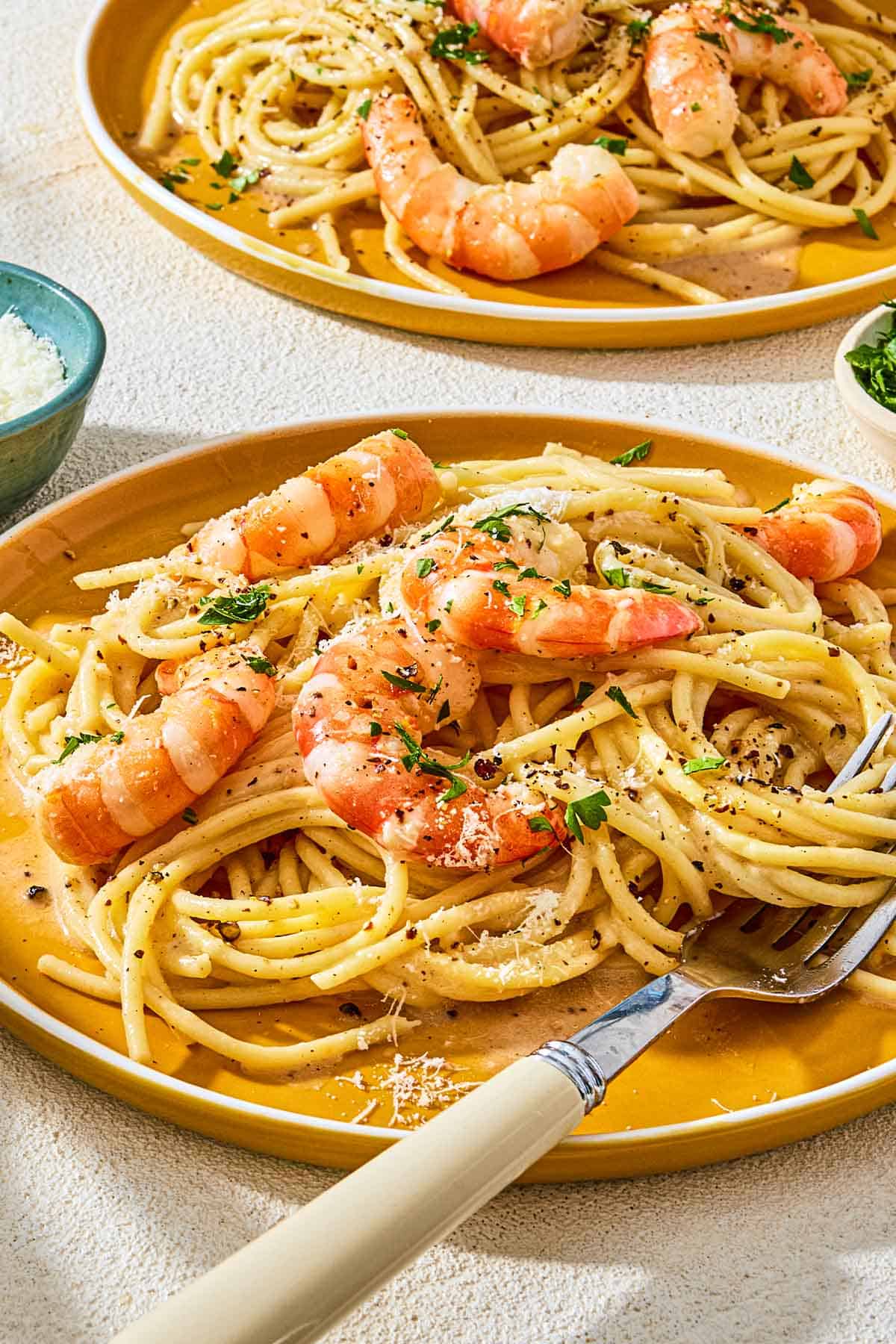
Ways to Mix it Up
Shrimp turns out to be a great pairing for Cacio e Pepe, but you don’t have to limit yourself. Here are some more ways to mix up this simple spaghetti with shrimp:
- Substitute small clams, such as littleneck or Manila, for the shrimp. Steam them open, and then sauté briefly in olive oil with garlic and any clam juice accumulated from the steaming process. Toss the cooked clams and pan juices with the cheesy pasta.
- If you’re a mussel lover (like me), try the same method using mussels instead of clams.
- For an extra-luxurious take, top each serving of Cacio e Pepe with cooked crab or lobster meat.
- What about tinned fish? Tinned fish is having a moment, so why not add it to your Cacio e Pepe? Try mackerel, tuna packed in oil, or sardines. Stir some of the flavorful oil from the tin into your Cacio e Pepe sauce, and top each serving with chunks of the tinned fish.
- For a dairy-free version, try my Shrimp Linguine. Or for a gluten-free version, try my Shrimp and Polenta.
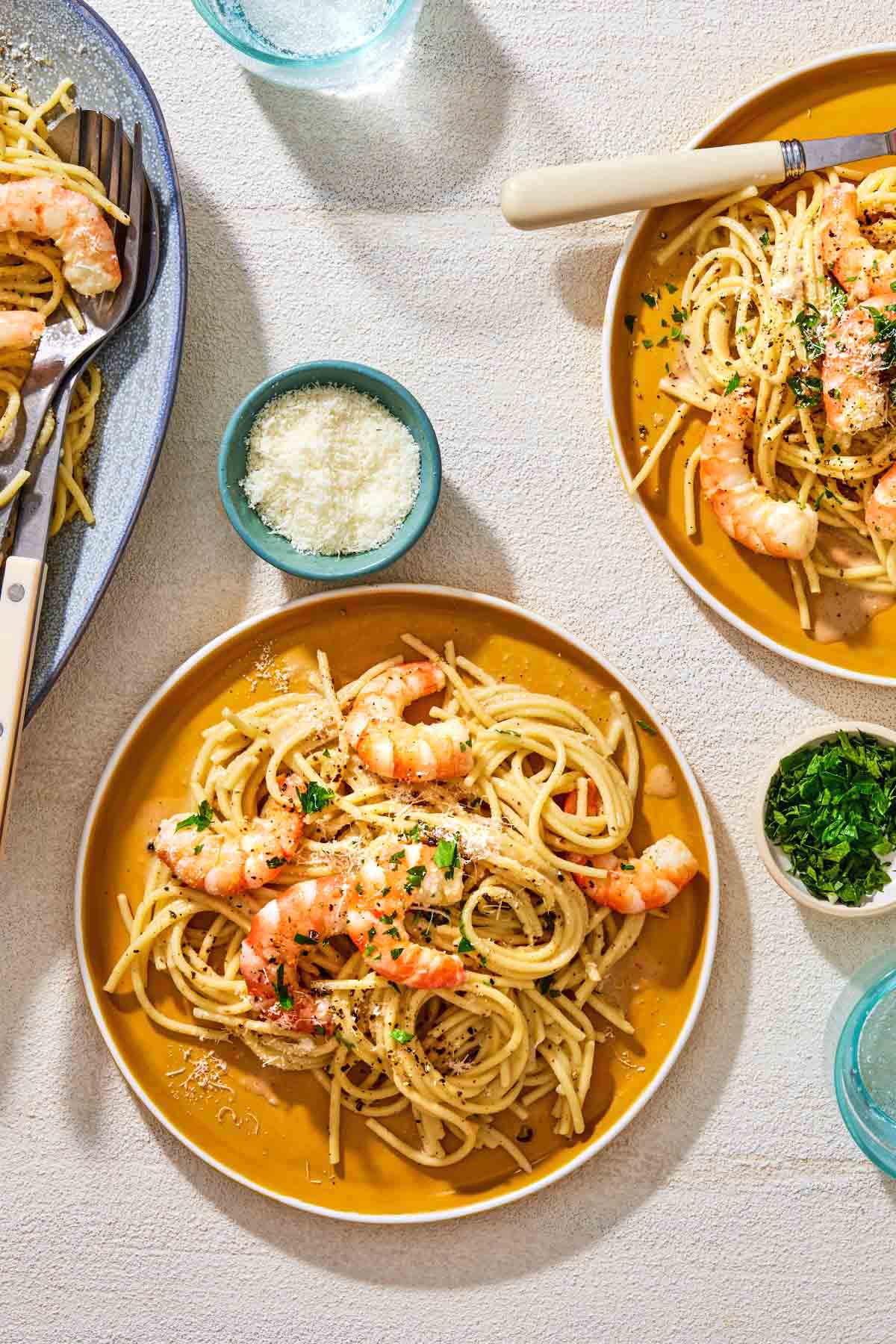
What to Serve with Shrimp Pasta
Spaghetti with shrimp and a simple salad like Lemon Parmesan Lettuce Salad is always a good pairing. But salad isn’t the only vegetable that goes well with shrimp pasta. Try these easy Roasted Green Beans with sliced almonds, or Roasted Broccoli with Lemon for a change. Love this flavor pairing? Serve Cacio e Pepe Cabbage on the side!
You’ll Also Like: More Shrimp Recipes
Browse all Mediterranean recipes.
Visit Our Shop
Try Our Authentic Italian Olive Oil
Hand-picked and cold extracted Extra Virgin Olive Oil from 100% Nocellara del Belice Sicilian olives.
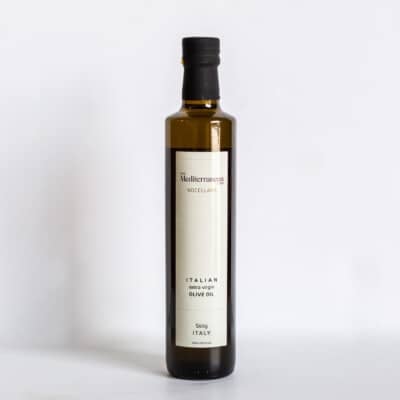
Cacio e Pepe with Garlicky Sautéed Shrimp
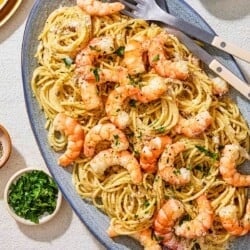
Ingredients
- 2 teaspoons kosher salt for the pasta water plus 1/2 teaspoon for the shrimp
- 1 tablespoon whole black peppercorns
- 3 tablespoons extra virgin olive oil
- 1 garlic clove minced
- 3 tablespoons dry white wine or dry vermouth
- Zest of 1 small lemon plus 2 tablespoons freshly squeezed juice
- 18 to 24 large shrimp about 3/4 pound, peeled and deveined
- 1 pound spaghetti
- 4 ounces Pecorino Romano finely grated
- Minced parsley leaves for garnish (optional)
Instructions
- Put the pasta water on to boil: Fill a large pot with water and set it over high heat. Bring it to a boil and add 2 teaspoons salt.
- While the pasta water is heating, toast and grind the peppercorns. In a large high-sided skillet set over medium-high heat, add the peppercorns. Toast, stirring occasionally just until they release their aroma. Cool slightly, then transfer them to a mortar or a spice grinder. Pound or grind the peppercorns to a mostly coarse grind with some finer specks but no large pieces.
- Boil the pasta. Add the pasta to the boiling salted water, turn the heat to medium-high, and cook according to package instructions until the pasta al dente. When the pasta is done, reserve 1 1/2 cups of pasta water, then drain the pasta.
- Sauté the shrimp while the pasta cooks. Return the peppercorn skillet to medium-low heat. Add the olive oil and garlic. Once the garlic starts to sizzle lightly, cook, stirring, for 2 minutes to soften. Raise the heat to medium and stir in the wine, lemon juice and zest. Let the liquid bubble for about a minute, then add the shrimp to the pan. Cook for about 2 minutes, until the shrimp is opaque on the bottom; turn and cook the shrimp on the other side until cooked through, 2 to 3 minutes more.
- Make a pan sauce. Using tongs, transfer the shrimp to a bowl and cover to keep warm. Turn up the heat on the pan to medium-high for 30 to 60 seconds to thicken the juices slightly, just enough to very lightly coat the back of a spoon. Turn off the heat (leaving the pan on the burner) and cover the skillet to keep the sauce warm.
- Dress the pasta. Transfer the drained pasta to the pan with the lemon garlic sauce. Add 1/3 cup of the reserved pasta water. Use tongs or a pasta spork to toss the noodles to coat them well. Sprinkle on about 1/3 of the cheese, 2 teaspoons of the crushed peppercorns, and a splash of the reserved pasta water. Stir vigorously to combine the ingredients. Add another splash of reserved pasta water and another 1/3 of the cheese and continue to stir with energy to coat the noodles evenly. The sauce should look smooth and creamy. Add more cooking water, a splash at a time (if necessary) to loosen the sauce. You may not use all of the pasta water.
- Serve: Transfer the pasta to individual bowls. Top each serving with a spoonful of remaining Pecorino and 3 to 4 shrimp. Sprinkle on a final pinch of pepper and the parsley (if using). Serve.
Notes
- I recommend using a microplane and freshly grating the cheese yourself so it’s light and fluffy, making it easier to combine with the starchy water.
- Make sure to stir very vigorously to make a creamy sauce and prevent clumping.
- Visit our shop to browse quality Mediterranean ingredients including olive oils, honey, jams, and spices.
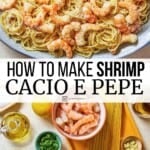
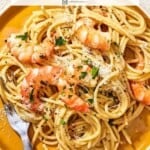
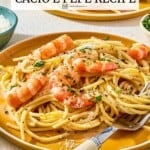
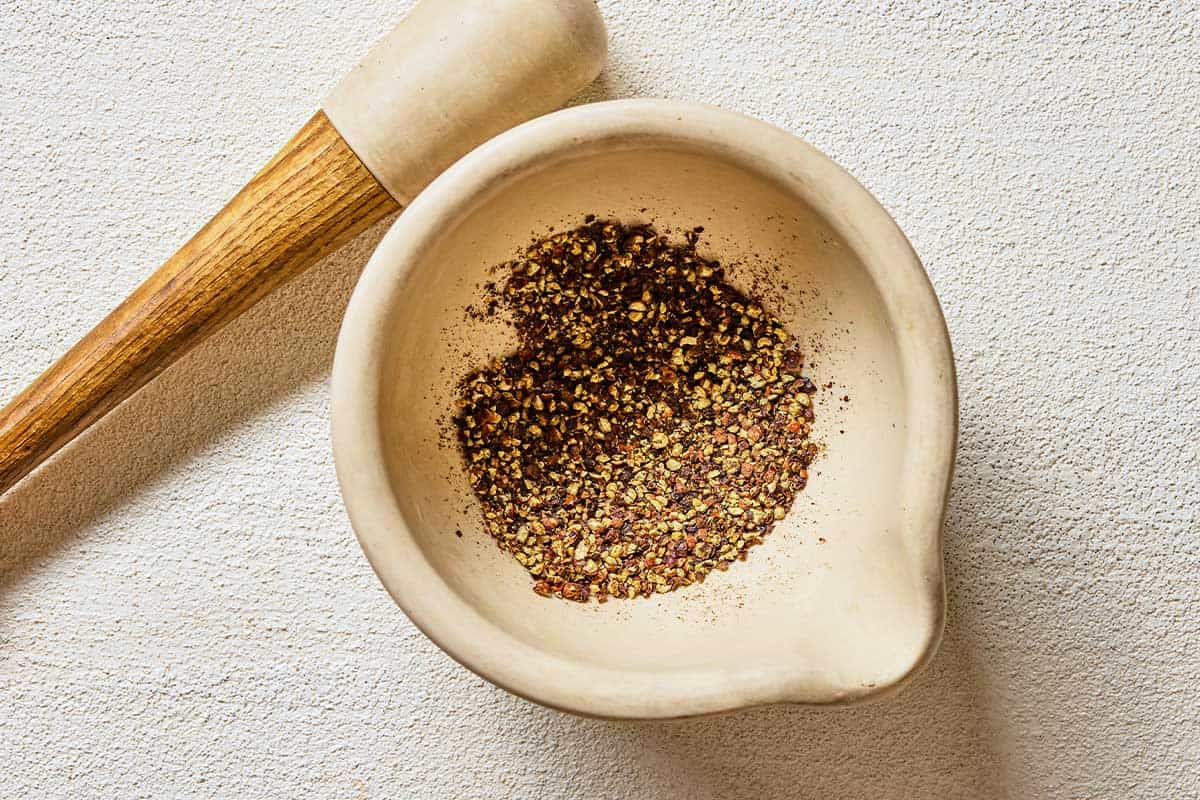
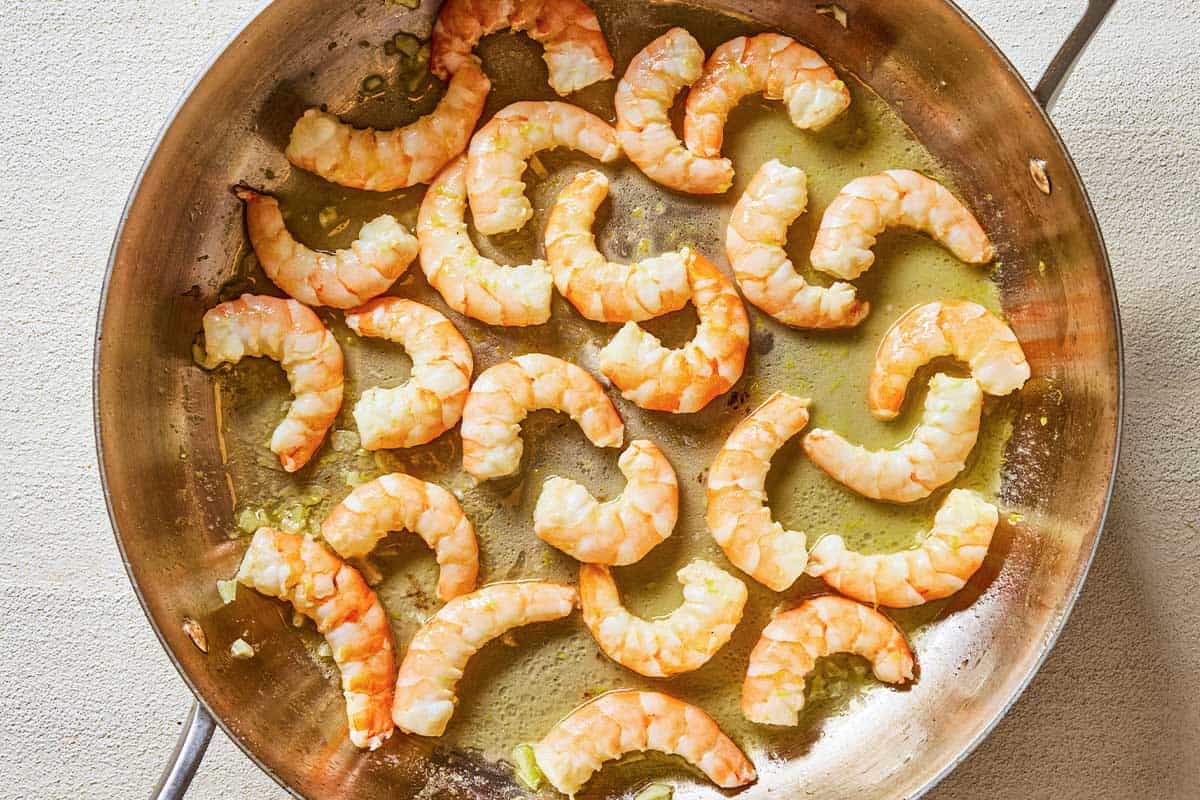
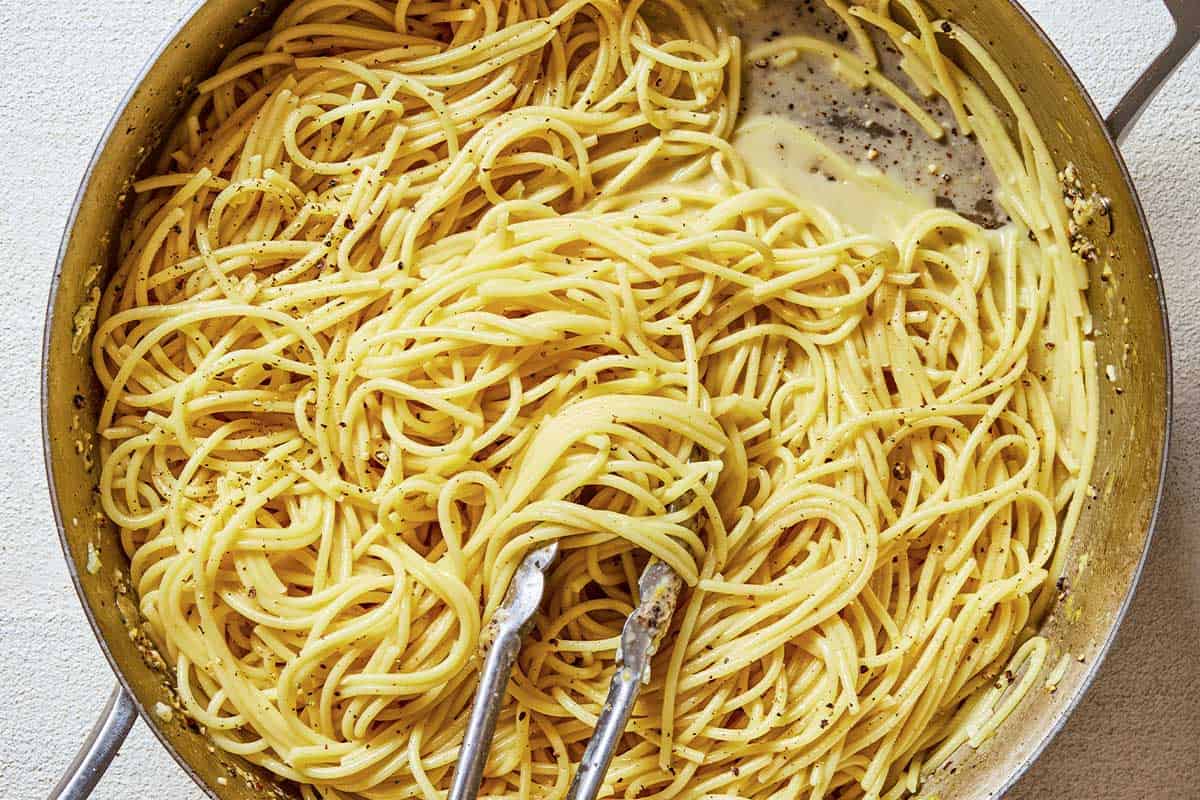
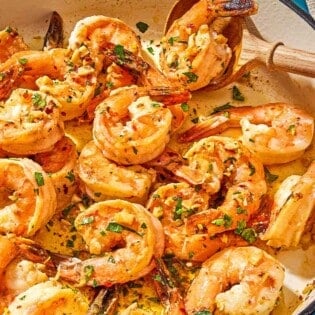
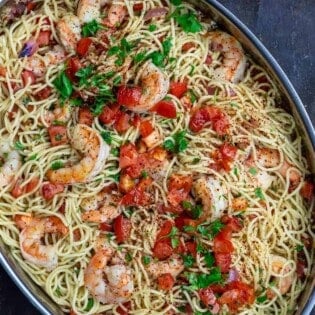
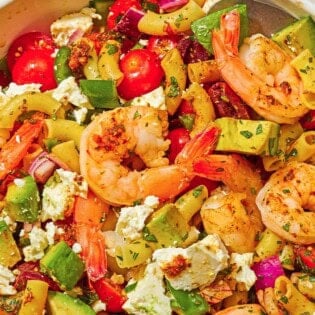
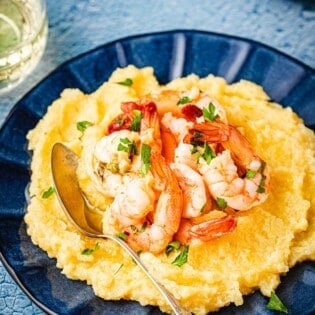
Hi Domenica! This looks delish and would love try. How crucial is the white wine? We’re a dry house and opening a bottle of wine for 3 tbsp would sadly be a waste in our home. ☹️
Hi, Amy. You can totally skip the wine here and add a little broth instead.
Oh MY! I flat out LOVED this. It was so light and so flavorful. THIS is one of my new favorites. I wish I had learned of this sooner. I’m 50 years old and have been missing out.
Haha! Thanks so much, Jen!
Can I use parmesan instead of pecorino?
Absolutely! Enjoy!
OMG! This was amazingly tasty and yummy. A favorite for sure. Thank you
Double that 5 stars.
Wow! Thanks so much!
So, this recipe is delicious and remarkably forgiving. I made a couple of errors, yet this dish is so amazing in spite of it. I will definitely make it again!
Thanks so much, Cathy!
Enjoyed cooking this and the whole loved it 100% yum
Glad to hear this was a hit, Rob! Thanks for taking the time to come back and leave a review.